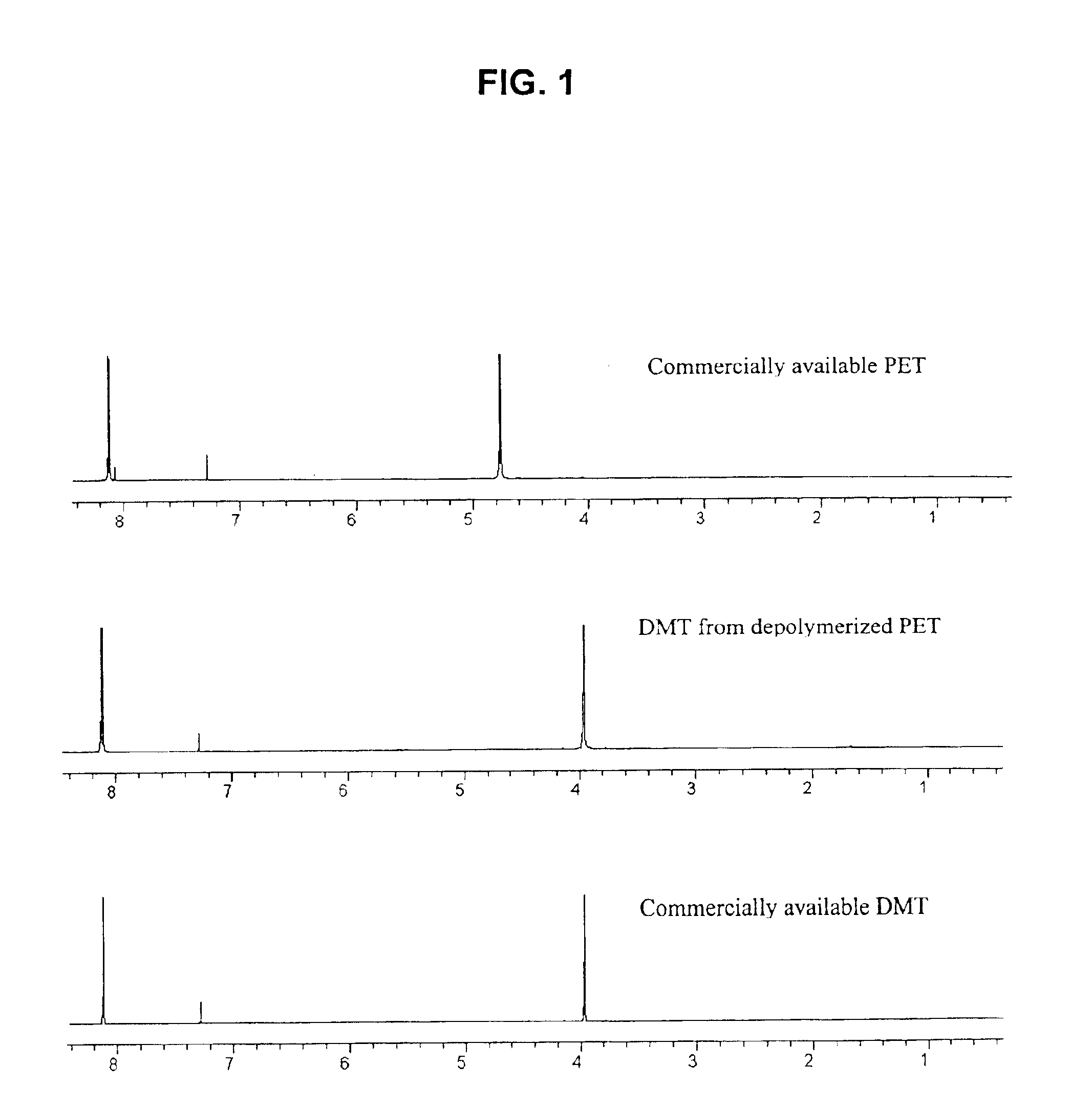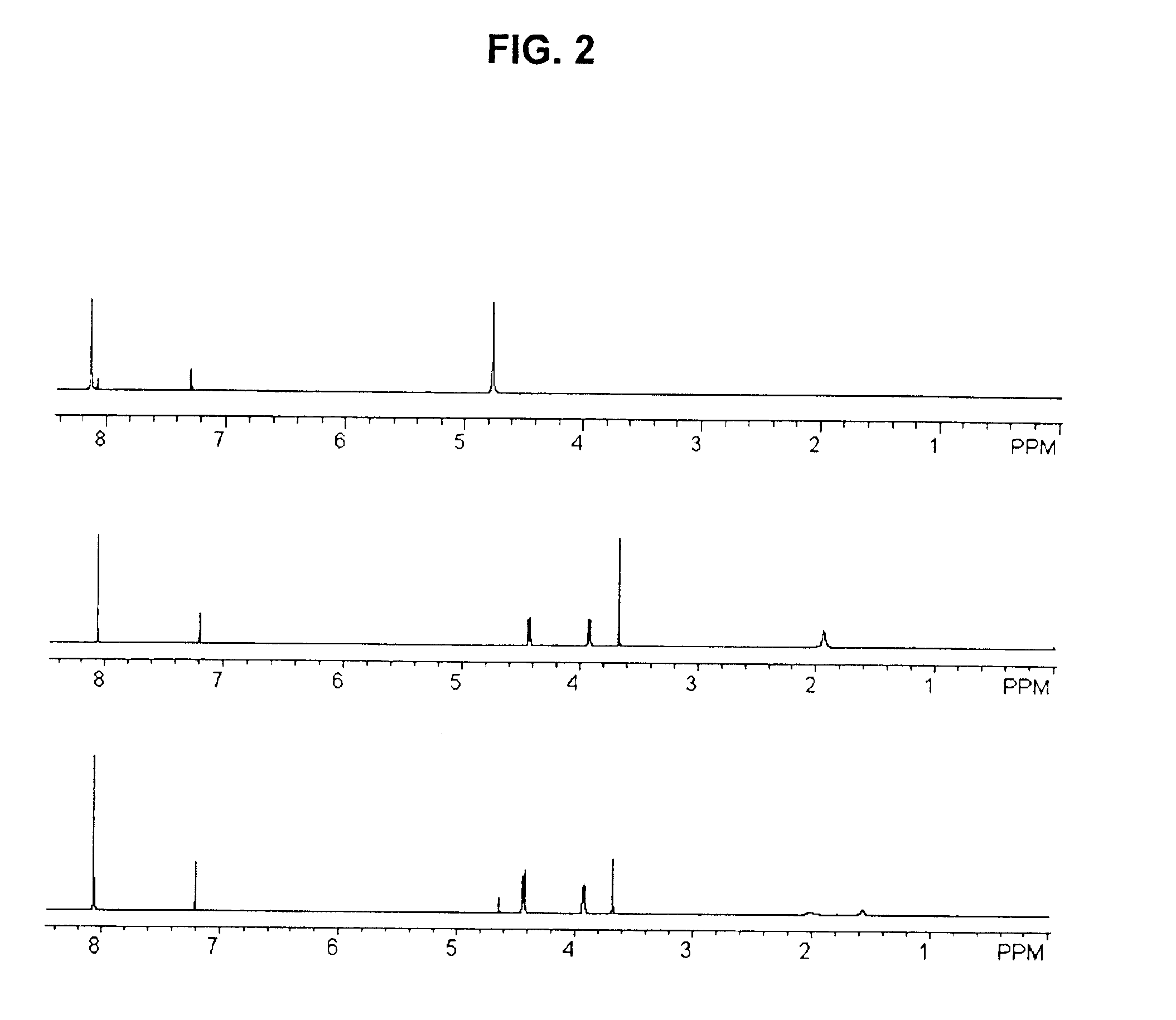Catalytic depolymerization of polymers containing electrophilic linkages using nucleophilic reagents
a nucleophilic reagent and polymer technology, applied in the preparation of ester-hydroxy reactions, chemistry apparatus and processes, organic chemistry, etc., can solve the problems of complex ecological problems, waste management and pollution prevention, and the critical shortage of landfill space faced by many communities
- Summary
- Abstract
- Description
- Claims
- Application Information
AI Technical Summary
Benefits of technology
Problems solved by technology
Method used
Image
Examples
example 1
[0107]Depolymerization of Poly(propylene carbonate) (Mw=50,000) with isolated carbene: 7 mg (0.02 mmol) of 1,3-(2,4,6-trimethylphenyl)imidazol-2-ylidene dissolved in toluene (0.6 mL), was added to a stirred mixture of 0.5 g of poly(propylene carbonate) in toluene (10 mL), under N2. After stirring for 5 minutes at room temperature, 2 mL of methanol were added to the reaction mixture and the temperature was brought to 80° C. Stirring was continued for 3 hours followed by the evaporation of the solvent in vacuo. The 1H and 13C NMR spectra showed the presence of a single monomer, 4-methyl-[1,3]-dioxolan-2-one. However, there were 4 peaks in the GC-MS.
GC-MS:
a) m / z (5%) 5.099 min=106 (42), 103 (5), 91 (100), 77 (8), 65 (8), 51 (8)
b) m / z (5%) 5.219 min=106 (60), 105 (30), 103 (8), 91 (100), 77 (8), 65 (5), 51 (5)
c) m / z (85%) 6.750 min=102 (15), 87 (40), 58 (20), 57 (100). Major product.
d) m / z (5%) 9.030 min=136(10), 135 (100), 134 (70), 120 (85), 117 (8), 103 (5), 91 (14), 77 (10), 65 (5)....
example 2
[0110]Depolymerization of Poly(Bisphenol A carbonate) (Mw=65,000) with isolated carbene: 7 mg (0.02 mmol) of 1,3-(2,4,6-trimethylphenyl)imidazol-2-ylidine dissolved in toluene (1 mL), was added to a stirred mixture of 0.5 g of poly(bisphenol A carbonate) in toluene (10 mL), under N2. After stirring for 5 minutes at room temperature, 2 mL of methanol were added to the reaction mixture. The temperature was brought to 80° C. and stirring was continued for 18 hours followed by the evaporation of the solvent in vacuo. The 1H and 13C NMR spectra showed the presence of two compounds identified as, bisphenol A and carbonic acid 4-[1-hydroxy-phenyl)-1-methyl-ethyl]-phenyl ester 4-[1-(4-methoxy-phenyl)-1-methyl-ethyl]phenyl ester. However, GC-MS indicated 4 peaks.
GC-MS:
a) m / z (5%) 5.107 min=106 (40), 103 (5), 91 (100), 77 (8), 65 (8), 51 (8)
b) m / z (5%) 5.210 min=106 (60), 105 (30), 103 (8), 91 (100), 77 (8), 65 (5), 51 (5)
c) m / z (60%)14.301 min 228 (30), 213 (100), 119 (15), 91 (10). Major pr...
example 3
[0112]Depolymerization of Poly(1,4-butylene adipate) (Mw=12,000) with isolated carbene: 0.006 g (0.02 mmol) of 1,3-(2,4,6-trimethylphenyl)imidazol-2-ylidine dissolved in toluene (1 mL), was added to a stirred mixture of 1.0 g of poly(1,4-butylene adipate) in toluene (10 mL), under N2. After stirring for 5 minutes at room temperature, 2 mL of methanol were added to the reaction mixture. The temperature was brought to 80° C. and stirring was continued for 6 hours followed by the evaporation of the solvent in vacuo. The 1H and 13C NMR showed the presence of a single product, and the GC-MS showed two products.
GC-MS:
a) m / z (95%) 5.099 min=143 (80), 142 (20), 115 (20), 114 (100), 111 (70), 101 (65), 87 (12), 83 (25), 82 (12), 74 (36), 73 (26), 69 (10), 59 (72), 55 (60). Major product.
b) m / z (5%) 12.199 min=201 (4), 161 (6), 143 (100), 129 (32), 116 (12), 115 (25), 111 (70), 101 (12), 87 (10), 83 (15), 73 (34), 71 (12), 59 (14), 55 (42).
[0113]1H NMR: 1.67 (m), 2.32 (s), 4.08 (s).
[0114]13C ...
PUM
| Property | Measurement | Unit |
|---|---|---|
| temperature | aaaaa | aaaaa |
| temperature | aaaaa | aaaaa |
| temperature | aaaaa | aaaaa |
Abstract
Description
Claims
Application Information
 Login to View More
Login to View More - R&D
- Intellectual Property
- Life Sciences
- Materials
- Tech Scout
- Unparalleled Data Quality
- Higher Quality Content
- 60% Fewer Hallucinations
Browse by: Latest US Patents, China's latest patents, Technical Efficacy Thesaurus, Application Domain, Technology Topic, Popular Technical Reports.
© 2025 PatSnap. All rights reserved.Legal|Privacy policy|Modern Slavery Act Transparency Statement|Sitemap|About US| Contact US: help@patsnap.com



